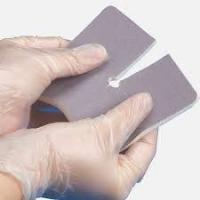The Continuum of Wound Dressings: Silver Dressings
It has long been known that silver is an effective antimicrobial. In fact, silver has been used as a topical antimicrobial agent for hundreds of years. In recent years, a large number of dressings containing silver compound or a compound that releases silver slowly over time have been developed, adding to the wound care dressing arsenal.
Unfortunately, in the last few years the use of silver in dressings has come under fire for several reasons, including perceived high cost, the fear that use of silver in dressings will lead to increased antibiotic resistance, and concerns regarding toxicity. Therefore, production and development of silver-containing dressings has been restricted somewhat and use of these dressings has fallen out of favour in some areas (Wounds International, 2011, p1).
Silver Dressing Indications
In 2011, an expert consensus panel met to examine the evidence for and against the use of silver in wound care management and make a determination based on the evidence as to the safety and efficacy of silver-containing dressings. Several myths about silver in wound care were put to a challenge and many were debunked. As a result of this, recommendations were made as to the appropriate use of silver (Wounds International, 2011, p6). The panel concluded that silver is appropriate for use in:
- decreasing bioburden in wounds that are infected or have stalled in healing due to the presence of microorganisms
- acting as a antimicrobial barrier to prevent infection in wounds that are identified as being at high risk for infection
Silver has been incorporated into virtually all classes of dressings and may be used as a primary or secondary dressing. Silver dressings vary considerably in their level of absorption. It should be noted that silver dressing use results in a characteristic bluish-black discoloration of the wound bed, and this should not be mistaken for infection or necrosis (Meyers, 2008).
Silver Dressing Precautions
There are a number of situations in which silver dressings should not be used. These include:
- Surgical wounds that are low risk for infection
- Pregnant or lactating women
- Patients who are sensitive or allergic to silver or metals
- Wounds being treated with an enzymatic debridement agent
- Wounds in which there are no signs and symptoms of infection present, whether localized or systemic
- Chronic wounds that are healing as expected
- In, on, or near sites that are being or have been treated with radiotherapy
- Small, acute wounds that are unlikely to become infected
- Wounds in which slough or necrotic tissue is present
- Wounds colonized with multiple organisms or biofilms
Silver dressings can be very effective for wounds that are infected, or wounds harboring large numbers of bacteria that have stalled in the healing process. There are numerous silver dressings available on the market. When used appropriately, silver dressings are cost-effective and safe to use and can significantly reduce wound bioburden.
If you are enjoying this series on wound care products, you may consider becoming certified as a wound care professional. Wound Educators is the premier online wound education site, preparing professionals to become nationally certified. If you would like to learn more about becoming a certified wound care professional, please contact us.
Sources
Meyers, B (2008). Wound Management: Principles and Practice. 2nd edition. Pearson Prentice Hall. Upper Saddle River, New Jersey. pg. 139-140.
Appropriate use of silver dressings in wounds: An expert working group consensus (2011). Wounds International. Retrieved March 14, 2015 from http://www.woundsinternational.com/media/issues/567/files/content_10381.pdf


august 15, 2017
i have skinned my leg and serium keeps flowing from a area about 5 inches
square. ( from little areas in that area. ) we have bandaged it and used serium absorbing bandages with no success.
what would you suggest??
thanks john
a
Hi John, I recommend that you obtain a consultation from a certified wound care specialist. you can search for a specialist here: https://portal.abwmcertified.org/ABWMweb/Directory/ABWMcontent/Directory.aspx
Best of luck.